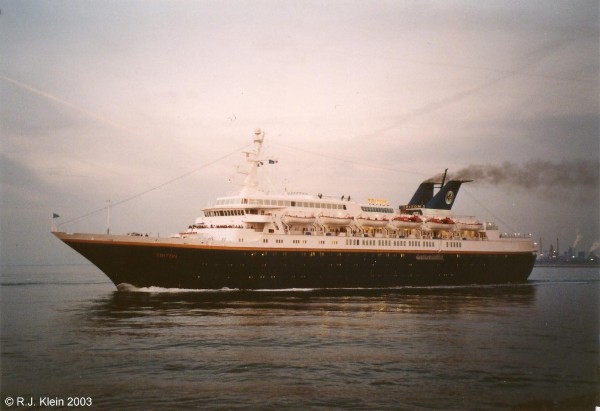Royal Olympic Cruises
Royal Olympic Cruises was formed in 1995 when two very well known Greek shippingcompanies combined forces. These were the Epirotiki Steamship Lines, founded in 1850 by Anastassios Potamianos, and the Sun Line, founded in 1957. Both companies were mostly sailing the Greek islands.
The merger was more or less especially needed for Epirotiki, the company had seen several disasters in their recent history and their financials were not as good as they used to be. Epirotiki had also been in the transatlantic trade in the good old days, but just as the other companies plying the Atlantic waters, they concentrated on cruising since the end of the 1960's/ beginning of the 1970's. In 1991, the Epirotiki cruiseliner Pegasus II burned at Venice and sank. Just two months later, another ship of the line, Oceanos, also sank and she was abandonned by her captain before every passengers had left the striken vessel. The untill then good reputation of the line was at stake and Epirotiki needed to sell their assets to saty afloat. Firstly, they looked to the industries largest, Carnival Cruise Lines. But, probably because of the financials, Carnival was not interested and instead, Epirotiki merged with Sun Line to form Royal Olympic Cruises. The new name was just an umbrella, both companies were still sailing under their own names untill 1997 when all marketing was towards Royal Olympic and the former names dissappeared. Sun Line and their fleet of three ships had always been fiancially very sound, so Epirotiki started to be a heavy load in the combine and this was the main reason to loose both names.
Below, Triton is seen when she was sailing for Royal Olympic Cruises and visited The Netherlands in the first and only season of Royal Olympic Cruises in western Europe in the summer of 2003. She took over from Stella Solaris, that had been send to the breakers instead.

In spite of the problems from the 1990's, the fresh combine could rely on the knowledge of especially Epirotiki and the combine created a good name for cruises in the eastern Mediterranean. The fleet was mostly the ships from the two lines, mainly older tonnage from the 1960's and 1970's. But in the 1990's more companies were roaming the Greek seas, especially the well-equipped and modern large lines. Royal Olympic targeted the more sophisticated, individual traveller and again, they faced hard times. At the end of the 1990's, Louis Cruise Line bought most of the assets of Royal Olympic, but after a few years they backed out again.
In the year 2000, Royal Olympic had an argument with the International Olympic Committee, who claimed the rights of the word 'Olympic' for the Olympic Games. So Royal Olympic had to change its name to Royal Olympia Cruises from 2001 onwards. Just before, the company had delivered its first newbuilt under the name Olympic Voyager, that also had to change its name to Olympia Voyager, just like any other ship within the fleet using the Olympic name. The first newbuilt was one of two ships, with 25.000 tons small in size, but this was what the passengers were used to.
Due to the companies financials, the ships were built under a specially formed company but this part of Royal Olympia was declared bankrupt because the company wasn't able to pay for the ships. At the end, the total company was affected and declared bankrupt in 2004. A restart was tried but failed and all ships of the line were sold to other parties.
On Castles Of The Seas, a number of ships is present that have sailed for the line. Grand Victoria is placed underneath this page, she sailed for Royal Olympic as World Renaissance. Next to her, the others are listed below.
Triton (1995-2004) is placed under Cunard Line
Olympic (-a) Countess (1998-2004) is placed under Cunard Line as Ocean Countess
Olympic (-a) Voyager (2000-2004) is placed under Iberocruceros as Grand Voyager
Next to those, Ocean Majesty has sailed for Epirotiki Lines in 1993 as Olympic and in 1994 as Homeric.

